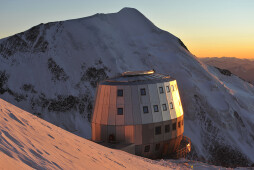The New Goûter Refuge at 3,835 m on Mont Blanc
Positioned with stunning overhangs on the "Aiguille du Goûter" (Goûter Needle), the refuge welcomes mountaineers on the final stage of their conquest of Europe's highest peak. The building, a wooden structure with metal cladding, represents a real structural and technical challenge when faced with the laws of nature.
The programme: The refuge must accommodate 120 people. It has a floor surface area of 720 m2. The ratio set by the FFCAM, The French Federation of Alpine Mountaineering Clubs, the client, is 6m2 per person.
The building is designed on four levels :
- Level 0: foyer, cloakrooms, store room and 'engine' room. - Level 1: communal living areas including, in particular, a dining room with panoramic views and the kitchen. - Level 2: infirmary, dormitories and caretakers' apartment. - Level 3: dormitories.
The wet rooms and washrooms on each level provide a level of comfort that is much appreciated by the mountaineers and the caretakers.
All the furniture is designed to be in harmony with the spirit of the location - in spruce.
The foundations, structure and façades:
The foundations are designed to secure the refuge on its ridge, where winds can exceed 300 km/h. These are comprised of 69 pilings anchored in hard rock, with an average depth of 12 m. Bolted onto this complex infrastructure, the sub-floor consists of a solid grid of beams and horizontal braces, made from glue-laminated Douglas pine. Its construction brought to a close the first phase of the project (October 2010).
At the heart of the project, the wooden structure in fir or spruce has a volume of approximately 400 m3. In order to limit the CO2 emissions associated with transportation, the wood was cut from the region's own forests, primarily in the St.-Gervais district. The glue-laminated wooden structure and assemblies are produced using beams coated with resin sealant, while the floors are created using hollow beams, which are light and easy to handle. The façades are insulated using fibre-boards made from recycled wood.
The cladding is a satin stainless steel with low reflectivity, while the external wooden Velux windows are equipped with argon-filled triple glazing.
The construction method is based on the use of modules pre-fabricated in a workshop. Dimensioned so as to be suitable for transportation, they are pieced together on-site like a game of Lego.
The challenge lay in the assembly of parts transported by helicopter, with a maximum load of 550 kg, where the aim was to avoid static flights.
Throughout the duration of the exercise, the helicopter rotation efficiency was to be 30%. Completion of the structural and external work marked the end of the second phase of the project (November 2011).
An energy-self-sufficient HEQ building.
The refuge is designed to function totally self-sufficiently, with maximum use of the available resources and energy. Thermal energy, intended to melt snow and produce clean hot water, is provided by 50m2 of thermal solar panels installed at the foot of the building.
Electricity is generated by 95m2 of photovoltaic solar panels installed on the façade and on the roof.
A biomass co-generation system running on rapeseed oil acts as a back-up system, for the production of both heat and electricity.
The air is treated by a highly efficient, dual-flow ventilation system, contributing to the refuge's ability to offer comfort that is unrivalled at this altitude. Its flow is adjusted automatically depending on the number of occupants. Combined with the building's well insulated walls, this system ensures that the heating requirements are met primarily through the heat emitted by the occupants.
The sanitation system was one of the most complex design elements, given the altitude and the lack of oxygen (40% less than at sea level). Featuring a siphonic drainage system, the toilets use only 1.2 litres of water per flush. The treatment technology used is the same as that found in submarines, featuring vacuum sealed WCs, biological processing, oxygenation and membrane filtration, active carbon filtering and UV processing, enabling recycling in the WCs and urinals and the drainage of bacteria-free water into the natural environment.
The sole exception to the use of completely renewable materials is the storage of gas used in the kitchen for cooking meals and a fuel-powered back-up unit for the co-generator.
Architectural form
The harmonious design of the façade is first and foremost a response to the need to integrate the building into a protected site of European interest, the Mont Blanc massif.
Consideration of three constraints: structure, technology and meteorological conditions led to the adoption of an elliptical plan, enabling the achievement of a perfect ovoid shape.
The main axis of the ellipse was positioned against the prevailing westerly wind, in order to accelerate the masses of air on the sides of the building and to create a vortex on the rear section, facilitating the natural depositing of snow on the melting unit.
The shell of the building, consisting of 128 trapezoidal or rectangular bevelled panels - depending on the level - is covered in satin-finished stainless steel. These bevelled surfaces, like those of Mont Blanc, are illuminated alternately, based on the progress of the sun across the sky.
Project Team
Architecture: Groupe-H (www.groupe-h.com), DecaLaage (www.decalaage.com) Structure Wood Engineer: Charpente-Concept (www.charpente-concept.com) HVP Engineer : Cabinet Strem (www.strem.fr) Dynamic Thermal Simulation: Albedo (www.albedo-energie.fr) Foundation Structure: Betech (www.betechsarl.com) Building Economist: Cabinet Denizou

























































